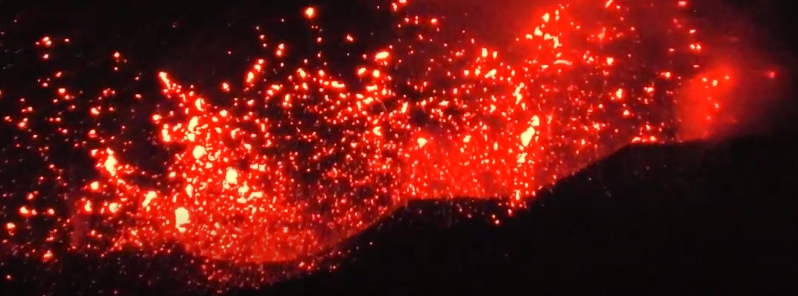Strombolian activity at Etna volcano’s New Southeast Crater, Italy

Strombolian activity returned to Etna volcano's New Southeast Crater over the past couple of days. An ash and steam plume rose up to approximately 3 500 m (11 500 feet) above the vent Monday into Tuesday, August 10 into 11, 2020.
Throughout the night, explosions had been almost continuous, with the volcano often spewing incandescent lava bombs on the outside flanks of the crater cone.
Overall, there was also a slightly increasing tendency of activity.
Etna spewed ash and steam plume up to around 3 500 m (11 500 feet) above the vent on August 10 into 11.
Meanwhile, intense degassing continues at the Voragine and Bocca Nuova summit craters.

Geological summary
Mount Etna, towering above Catania, Sicily's second-largest city, has one of the world's longest documented records of historical volcanism, dating back to 1500 BCE. Historical lava flows of basaltic composition cover much of the surface of this massive volcano, whose edifice is the highest and most voluminous in Italy.
The Mongibello stratovolcano, truncated by several small calderas, was constructed during the late Pleistocene and Holocene over an older shield volcano. The most prominent morphological feature of Etna is the Valle del Bove, a 5 x 10 km (5.1 x 6.2 miles) horseshoe-shaped caldera open to the east.
Two styles of eruptive activity typically occur at Etna. Persistent explosive eruptions, sometimes with minor lava emissions, take place from one or more of the three prominent summit craters, the Central Crater, NE Crater, and SE Crater (the latter formed in 1978). Flank vents, typically with higher effusion rates, are less frequently active and originate from fissures that open progressively downward from near the summit (usually accompanied by strombolian eruptions at the upper end).
Cinder cones are commonly constructed over the vents of lower-flank lava flows. Lava flows extend to the foot of the volcano on all sides and have reached the sea over a broad area on the SE flank. (GVP)
Featured image credit: INGVvulcani/YouTube

Commenting rules and guidelines
We value the thoughts and opinions of our readers and welcome healthy discussions on our website. In order to maintain a respectful and positive community, we ask that all commenters follow these rules.